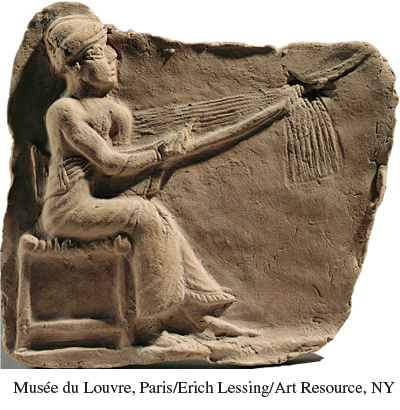A History of Western Society: Printed Page 14
A History of Western Society, Value Edition: Printed Page 15
A History of Western Society, Concise Edition: Printed Page 17
Sumerian Politics and Society
Exactly how kings emerged in Sumerian society is not clear. Scholars have suggested that during times of emergencies, a chief priest or perhaps a military leader assumed what was supposed to be temporary authority over a city. He established an army, trained it, and led it into battle. Temporary power gradually became permanent kingship, and sometime before 2450 B.C.E. kings in some Sumerian city-
Military leaders were sometimes able to conquer other cities, and in about 2350 B.C.E. Lugalzagesi, king of the city of Umma, conquered a number of other city-
Kings made alliances with other powerful individuals, often through marriage. Royal family members were depended upon for many aspects of government. Kings worked closely with religious authorities and relied on ideas about the kings’ connections with the gods, as well as the kings’ military might, for their power. Royal children, both sons and daughters, were sometimes priests and priestesses in major temples. Acting together, priests, kings, and officials in Sumerian cities used force, persuasion, and taxation to maintain order, keep the irrigation systems working, and keep food and other goods flowing.

The king and his officials held extensive tracts of land, as did the temple; these lands were worked by the palace’s or the temple’s clients, free men and women who were dependent on the palace or the temple. They received crops and other goods in return for their labor. Although this arrangement assured the clients of a livelihood, the land they worked remained the possession of the palace or the temple. Some individuals and families owned land outright and paid their taxes in the form of agricultural products or items they made. At the bottom rung of society were slaves. Slavery predates written records, so like many other aspects of social hierarchies, we are not sure exactly how and when people first began to own other people. Like animals, slaves were a source of physical power for their owners, providing them an opportunity to amass more wealth and influence. Some Sumerian slaves were most likely prisoners of war and criminals who had lost their freedom as punishment for their crimes; others perhaps came into slavery to repay debts. Compared to many later societies, slaves were not widely used in Sumer, where most agricultural work was done by dependent clients. Slaves in Sumer also engaged in trade and made profits. They could borrow money, and many slaves were able to buy their freedom.
Each of the social categories included both men and women, but their experiences were not the same, for Sumerian society made distinctions based on gender. Most elite landowners were male, but women who held positions as priestesses or as queens ran their own estates, independently of their husbands and fathers. Some women owned businesses and took care of their own accounts. They could own property and distribute it to their offspring. Sons and daughters inherited from their parents, although a daughter received her inheritance in the form of a dowry, which technically remained hers but was managed by her husband or husband’s family after marriage. The Sumerians established the basic social, economic, and intellectual patterns of Mesopotamia, and they influenced their neighbors to the north and east.